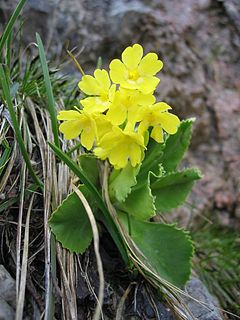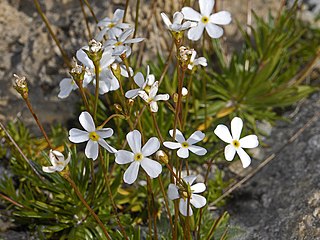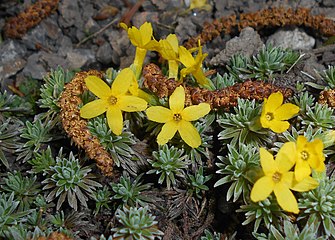
Primula is a genus of mainly herbaceous flowering plants in the family Primulaceae. They include the familiar wildflower of banks and verges, the primrose. Other common species are P. auricula (auricula), P. veris (cowslip) and P. elatior (oxlip). These species and many others are valued for their ornamental flowers. They have been extensively cultivated and hybridised - in the case of the primrose, for many hundreds of years. Primula are native to the temperate northern hemisphere, south into tropical mountains in Ethiopia, Indonesia and New Guinea, and in temperate southern South America. Almost half of the known species are from the Himalayas.

The Primulaceae, commonly known as the primrose family, are a family of herbaceous and woody flowering plants including some favorite garden plants and wildflowers. Most are perennial though some species, such as scarlet pimpernel, are annuals. It includes the former families Myrsinaceae, Theophrastaceae and Maesaceae.

An alpine garden is a domestic or botanical garden specialising in the collection and cultivation of alpine plants growing naturally at high altitudes around the world, such as in the Caucasus, Pyrenees, Rocky Mountains, Alps, Himalayas and Andes.

Primula sect. Dodecatheon is a section of herbaceous flowering plants in the family Primulaceae. Primula species in this section were formerly considered in a separate genus, Dodecatheon. The species have basal clumps of leaves and nodding flowers that are produced at the top of tall stems rising from where the leaves join the crown. The genus is largely confined to North America and part of northeastern Siberia. Common names include shooting star, American cowslip, mosquito bills, mad violets, and sailor caps. A few species are grown in gardens for their showy and unique flower display.

Androsace, commonly known as rock jasmine, is a genus of flowering plants in the family Primulaceae, second only to Primula in the number of species. It is predominantly Arctic–alpine, with many species in the Himalayas, the mountains of central Asia, the Caucasus, and the southern and central European mountain systems, particularly the Alps and the Pyrenees.

Primula vulgaris, the common primrose, is a species of flowering plant in the family Primulaceae, native to western and southern Europe, northwest Africa, and parts of southwest Asia. The common name is primrose, or occasionally common primrose or English primrose to distinguish it from other Primula species also called primroses. None of these are closely related to the evening primroses.

Primula auricula, often known as auricula, mountain cowslip or bear's ear, is a species of flowering plant in the family Primulaceae, that grows on basic rocks in the mountain ranges of central Europe, including the western Alps, Jura mountains, the Vosges, the Black Forest and the Tatra Mountains.

Primula lutea is a species of primrose that grows on basic rocks in the mountain ranges of southeastern Europe, including the southern and eastern Alps, southern Carpathians, Apennines, and the Balkans. The leaves are obovate and stalkless, with a cartilaginous edge, all growing in a basal rosette. The yellow flowers grow in clusters on 5–20 cm long stalks.

Primula elatior, the oxlip, is a species of flowering plant in the family Primulaceae, native to nutrient-poor and calcium-rich damp woods and meadows throughout Europe, with northern borders in Denmark and southern parts of Sweden, eastwards to the Altai Mountains and on the Kola Peninsula in Russia. In the British Isles, it is rarely seen outside East Anglia. It may be found near settlements, as far north as northern Norway, after escaping cultivation.

Neotinea ustulata is a European terrestrial orchid native to mountains in central and southern Europe, growing at up to 2,400 m (7,900 ft) elevation. The plant is considered Endangered in Great Britain and Least Concern internationally based on IUCN Red List criteria. The burnt-tip orchid was voted the county flower of Wiltshire in 2002 following a poll by the wild flora conservation charity Plantlife.

Scilla bifolia, the alpine squill or two-leaf squill, is a herbaceous perennial plant growing from an underground bulb, belonging to the genus Scilla of the family Asparagaceae.

Androsace lactea, the milkwhite rock jasmine, is an alpine plant, in the family Primulaceae.

Iris spuria subsp. maritima is a species of the genus Iris, part of a subgenus series known as Iris subg. Limniris and in the series Iris ser. Spuriae. It is a subspecies of Iris spuria, a beardless, rhizomatous perennial plant, from coastal regions Europe and north Africa with deep blue-violet flowers.

Iris arenaria is a species in the genus Iris; it is also in the subgenus of Iris and in the Psammiris section. It is a rhizomatous perennial, from Central Europe, found in Hungary, Austria, Romania, Czech Republic and Ukraine. It has grass-like leaves, a short stem and pale yellow flowers. It has had a mixed origin and was once Iris humilis subsp. arenaria, a subspecies of Iris humilis, until it was reclassified as a separate species. But many sources still state that it is either a synonym or subspecies of Iris humilis. It is cultivated as an ornamental plant in temperate regions.
Pomatosace filicula is a species of flowering plant in the family Primulaceae, endemic to the Qinghai–Tibetan Plateau in China.

Galanthus reginae-olgae, Queen Olga's snowdrop, is a species of flowering plant in the family Amaryllidaceae, native to Sicily and the west and north-west Balkans. Some variants produce their pendant white flowers in autumn, others in winter and early spring. It is cultivated as ornamental bulbous plant, preferring warmer situations in the garden than other species of Galanthus (snowdrops).

Androsace laevigata, synonym Douglasia laevigata, known as the cliff dwarf primrose, is a species of flowering plant in the primrose family, Primulaceae. It is native to the central Pacific coastal mountains of North America below 2,400 metres (8,000 ft) elevation. Its habitat includes cliffs, rocks, and alpine.
Androsace americana, synonym Douglasia arctica, known as the Mackenzie River dwarf primrose, is a species of flowering plant in the primrose family, Primulaceae. It is native to subarctic North America.

Primula capitata, commonly known as the round-headed Himalayan primrose or Asiatic primrose is a species of flowering plant in the family Primulaceae. It is a short-lived perennial, forming semi-evergreen rosettes of 15cm pale green, mealy leaves that are finely toothed, oblong-lance-shaped or inversely lance-shaped, with white-mealy undersides. Its flowers are up to 1cm long, dark purple and tubular, with shallowly lobed petals; they are borne in racemes that form flattened spheres, held on white-mealy stems about 40cm high.
Androsace helvetica is a plant in the family Primulaceae. Androsace helvetica is widely distributed in the Alps, where it is absent from areas with siliceous bedrock and is rare and scattered in the south‐eastern Alps east of the Dolomites. Several occurrences are known from the central Pyrenees. It is a characteristic species of alpine and subnival communities on dry and exposed limestone rocks or calcareous schists. It forms dense, often hemispherical cushions, with imbricate dead leafs below the leaf rosette and exclusively simple hairs on the leaves.



















